The Best Garam Masala Substitute (+ Recipe and More)
Garam masala is a complex aromatic blend of warm spices. It is an iconic ingredient in Indian cooking. But don’t worry if you’ve run out! This post has a homemade garam masala recipe and a list of the best garam masala substitutes.
Are you in the mood for a specific Indian dish but ran out of garam masala? No problem! This homemade garam masala recipe packs loads of Indian flavour. Or try an easy garam masala substitute with common pantry staple spices.
Garam masala is a blend of ground spices commonly used in Indian cooking. It typically includes cumin, coriander, cardamom, cinnamon, cloves, and black pepper. However, if you don’t have all the spices, you can still create a delicious substitute for garam masala.
One easy option is to combine equal parts ground cumin, coriander, and cardamom, along with a pinch of ground cinnamon and cloves. Or, for the best alternative, make homemade garam masala.
Whichever substitute you choose, you can create a delicious garam masala substitute to add maximum flavour to your next Indian curry.
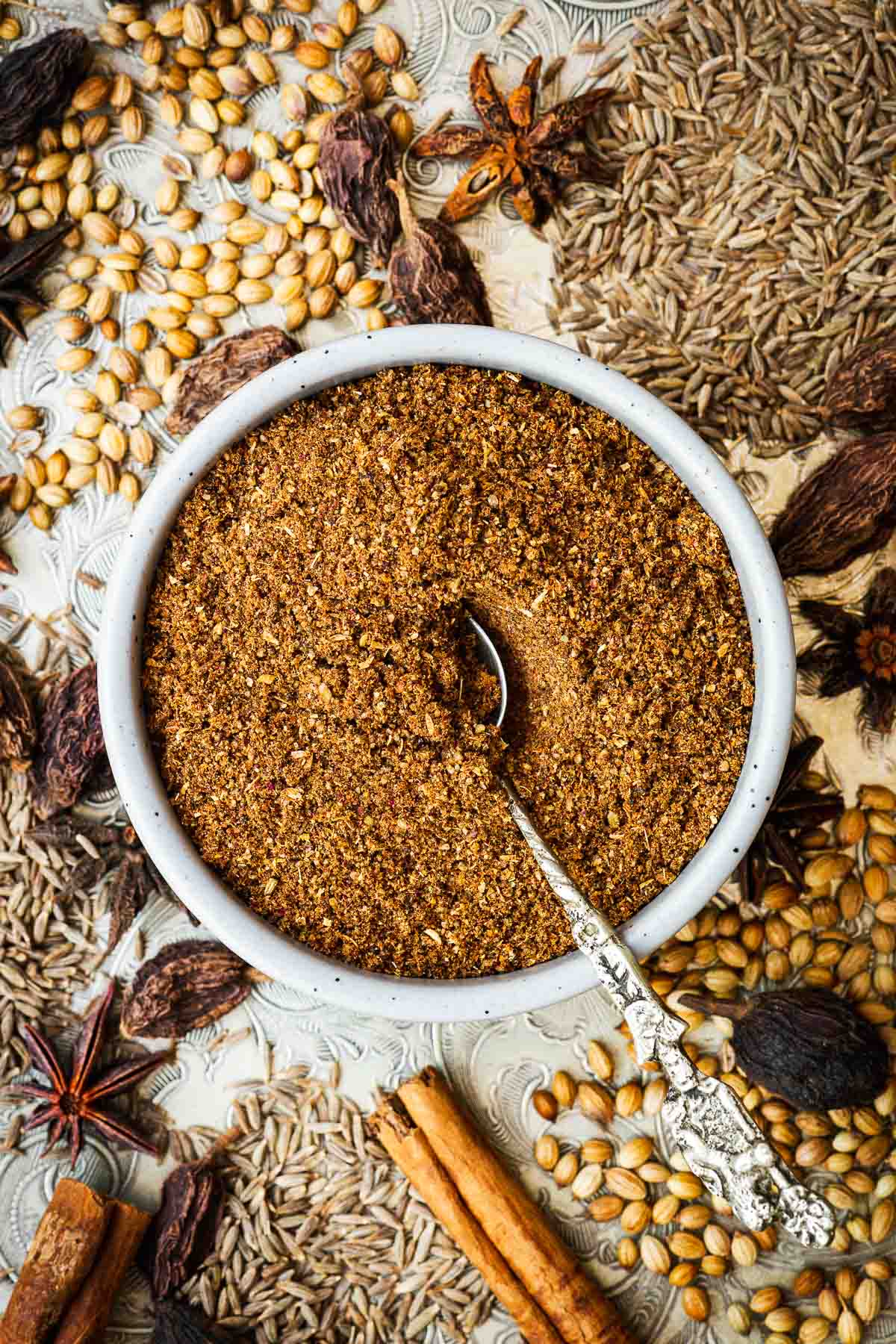
Keep reading to learn more about the iconic spice blend, or go straight to the section that interests you most:
- Garam masala ingredients
- How to make garam masala (with whole spices)
- The best garam masala substitutes
- NOT the best garam masala alternatives
- Frequently asked questions
Or, if you’re ready for the best garam masala spice blend, jump straight to the garam masala recipe card.
What is garam masala?
Garam masala is a blend of ground spices commonly used in Indian cuisine. It typically includes cumin, coriander, cardamom, cinnamon, cloves, and black pepper. However, the exact combination of spices can vary depending on the region and the cook’s preference.
Many households in India and other South Asian countries make their own garam masala blend. But it is also widely available in pre-packaged form in grocery stores and spice shops.
Indian cooks often add garam masala towards the end of cooking or sprinkle it over the final dish.
Use the versatile spice blend in both savoury and sweet dishes, such as curries, soups or desserts.
Garam masala ingredients
Garam masala typically consists of warm and aromatic Indian spices.
While the exact mix of spices varies, the main ingredients in garam masala are cumin, coriander, black cardamom, cinnamon, cloves, and black pepper.
Cumin adds an earthy flavour to the blend, whereas coriander has a light and citrusy taste that complements the other spices well. Black cardamom is intensely savoury and smoky. Cinnamon and cloves add a warm and sweet taste to the blend, while black pepper contributes a spicy and sharp taste that balances the other ingredients.
Typical garam masala can include many different spices (the main ingredients are in bold):
- cumin seeds
- coriander seeds
- whole black cardamom pods
- cinnamon
- cloves
- black pepper
- green cardamom seeds
- fennel seeds
- star anise
- bay leaf
- mace blades
- poppy seeds
- dried rose petals
With all these interesting flavours, you can see why a good garam masala spice blend is so complex and beautiful.
Now that we know what goes into garam masala, we can learn how to make garam masala at home. Or, understanding all the different flavours, find good substitutes for when you’re in a pinch.
How to make garam masala with whole spices
Whole spices start to lose their intensity once ground. So, the fresher the ground, the better the flavour. And, if you have a spice grinder, freshly toasted whole spices will make the most flavourful spice blend.
But don’t worry if you don’t have a spice grinder. The post has a variety of curry powder alternatives that won’t need one (like complex garam masala substitute from ground spices or this simple ground spice mix).
Step 1: Get your spices ready
The homemade curry powder blend in the recipe card has a delightfully complex flavour profile thanks to all the different spices. Use as many of these spices as you have at home.
But don’t fret if you are missing one or two ingredients. Adjust the spice blend with what you have for an easy garam masala substitute.
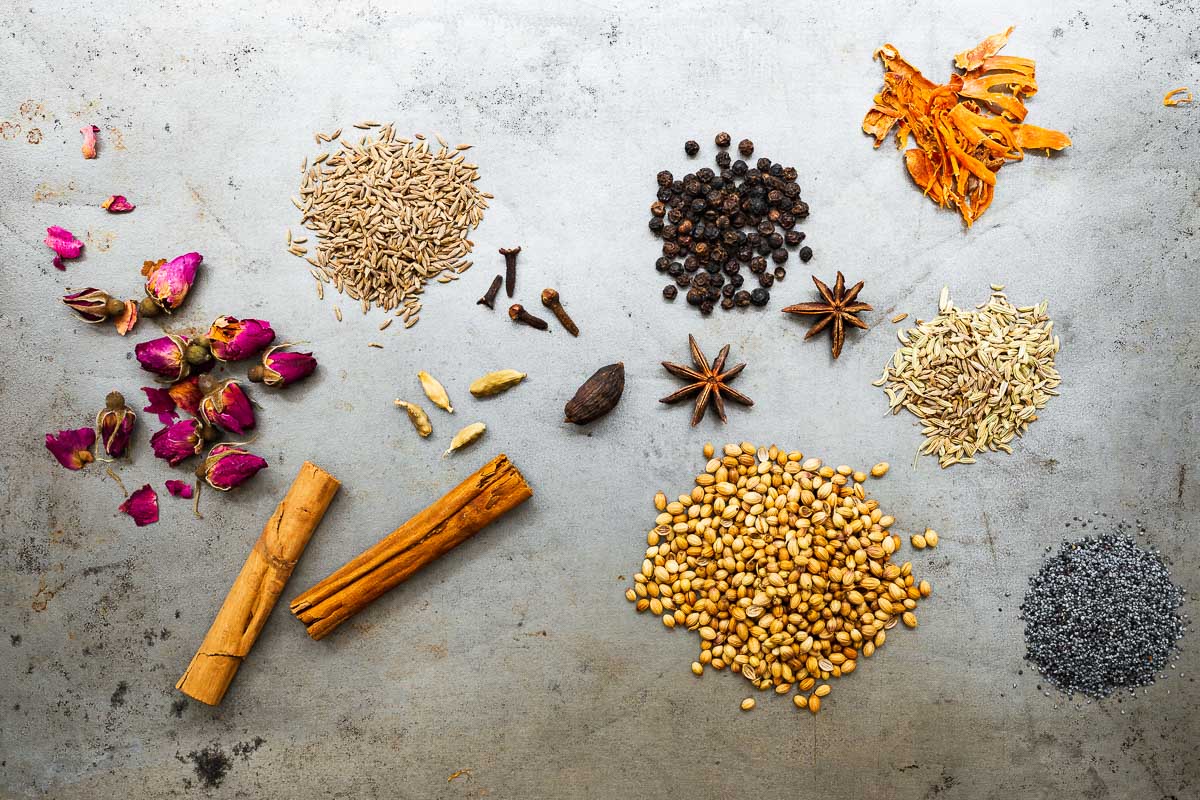
Step 2: Toast whole spices
You can toast spices in the oven or with a dry skillet on the stovetop.
Oven method
Heat a conventional oven to 160 °F (70 °C) – or 120 °F (50 °C) for a fan oven. Spread all the ingredients apart from the poppy seeds and rose petals on a rimmed baking sheet. And place it in the preheated oven for 2 ½ hours.
Add the poppy seeds and rose petals to the baking tray and return it to the oven. Turn the oven off and allow the spice mixture to cool in the switched-off oven for 30 minutes.
I like the oven method because the low-temperature toasting significantly reduces the risk of burning the spices. And they get a golden even roast. But the easy stovetop method only takes a few minutes, so I prefer it when I’m short on time.
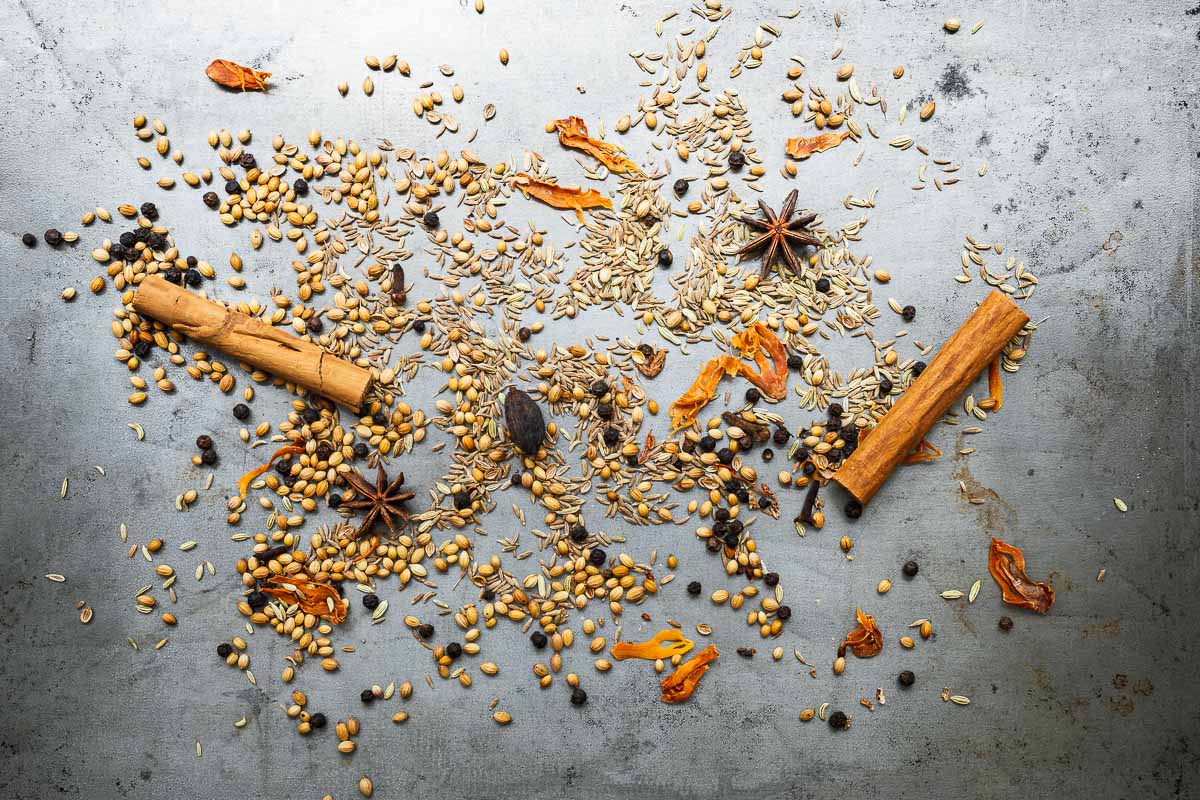
Stovetop method
Place a cold frying pan on high heat. Add everything apart from the poppy seeds and rose petals, and toast for 3 minutes. Then remove the pan from the heat.
Add the poppy seeds and rose petals to the frying pan and allow the spices to cool down in the hot pan.
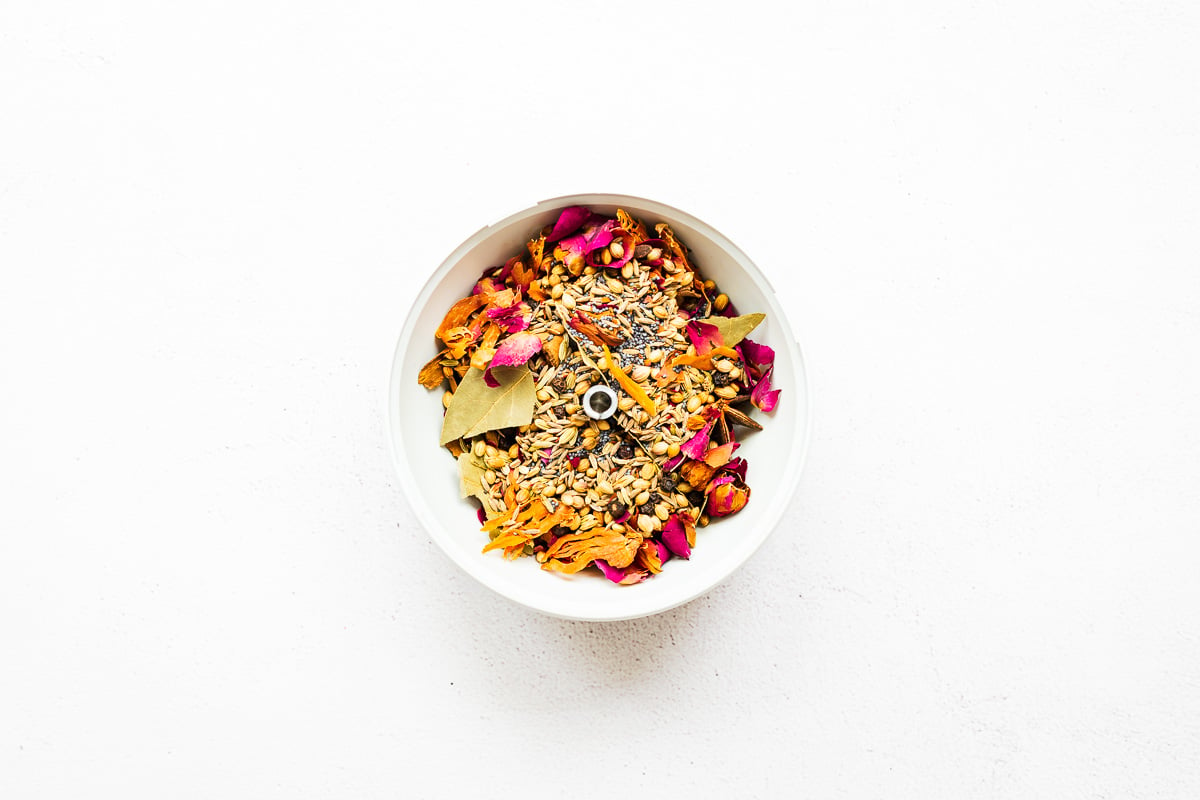
Step 3: Blend the spice mix
Put the cooled toasted spices in a spice grinder (or coffee grinder). And blitz until you have a fine powder.
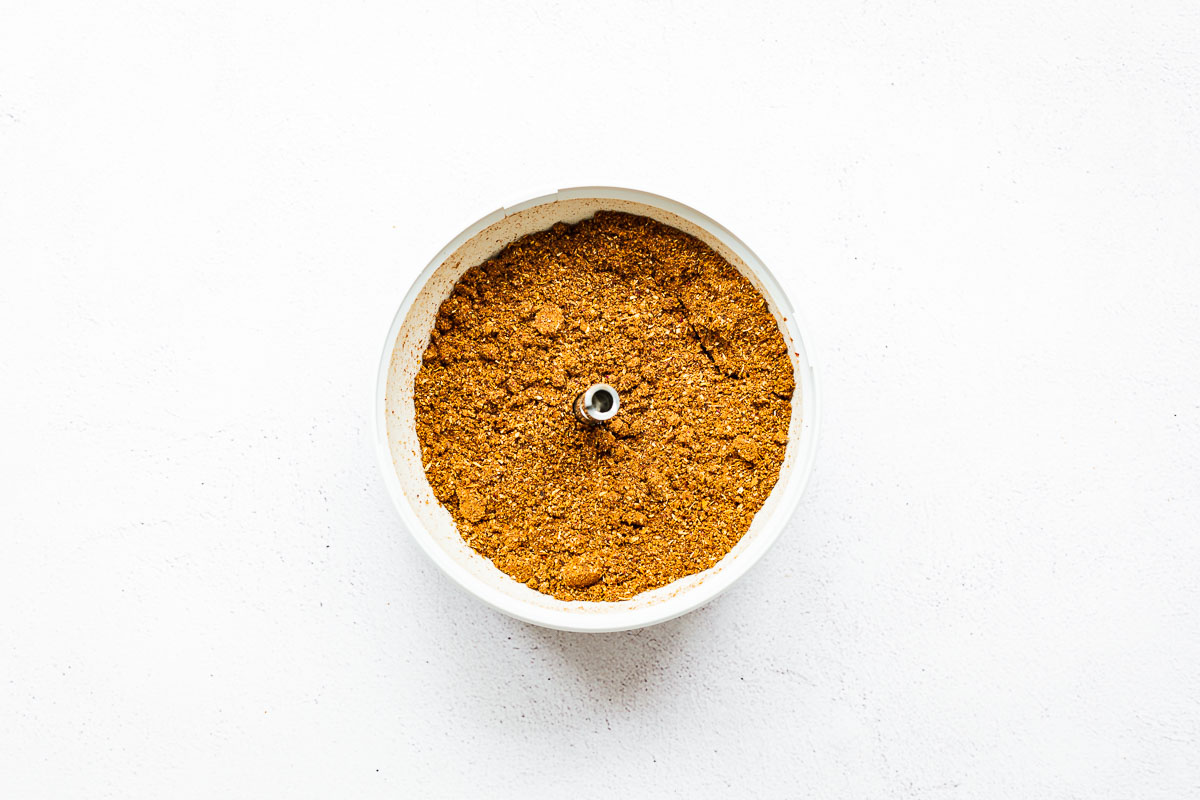
The 10 best substitutes for garam masala
If you’re a fan of Indian cuisine, you know that garam masala is a crucial ingredient in many dishes. But what if you don’t have garam masala or can’t find it in your local grocery store?
Luckily, several spice combinations and shop-bought alternatives can make delicious and aromatic garam masala substitutes. Whether you’re making a spicy curry or a sweet dessert, these substitutes will add that garam masala flavour you’re looking for.
In this article, we’ll explore some of the best garam masala substitutes and provide tips for using them in your cooking:
- Homemade garam masala (from whole spices)
- Complex garam masala substitute (from ground spices)
- Simple garam masala substitute (main ingredients only)
- Cumin, coriander and cinnamon
- Curry powder
- Chinese five-spice
- Allspice
- Pumpkin spice
- Lebanese seven-spice (baharat)
- Ras el hanout
1. Homemade garam masala (from whole spices)
You can make authentic garam masala at home. All you need is a spice grinder (or coffee grinder) and a well-stocked spice rack.
The spice blend in this garam masala recipe uses a variety of whole spices. Use as many of these for a beautifully complex spice blend:
- black and green cardamom
- cloves
- black peppercorns
- cinnamon quills
- coriander seeds
- cumin seeds
- fennel seeds
- star anise
- bay leaf
- mace blades
- poppy seeds
- dried rose petals
See the recipe card for detailed instructions to toast and grind your spices into garam masala.
While this freshly toasted spice mix is even better than shop-bought garam masala, it does have some drawbacks:
- It requires a spice grinder (or a mortar and pestle with serious arm strength).
- It is difficult to make small amounts at a time.
- It needs a pantry stocked with many different Indian spices.
If you don’t have a grinder, try the complex garam masala substitute from ground spices instead.
Or, if your spice rack lacks the more exotic Indian spices (like black cardamom and mace blades), try the simple garam masala substitute with only the main garam masala ingredients.
Or keep browsing this list until you find your perfect fit!
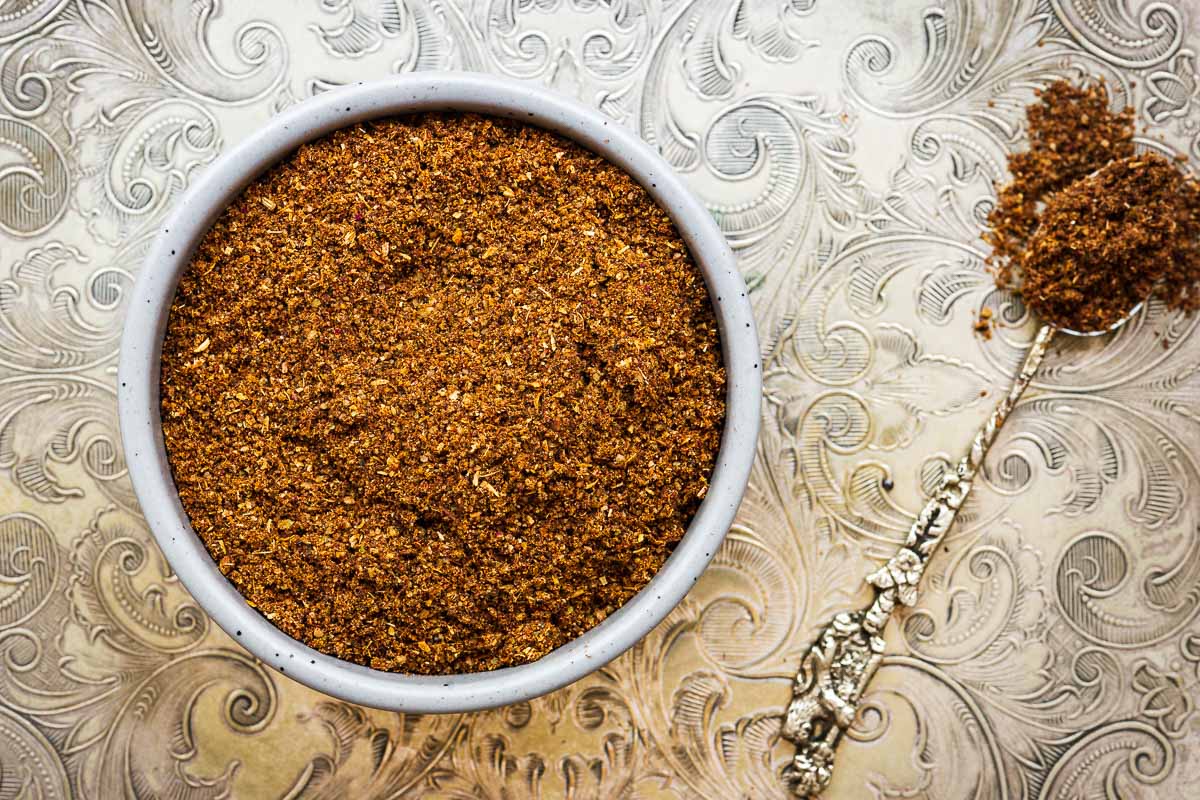
2. Complex garam masala substitute (from ground spices)
If you don’t have a spice grinder to make your own garam masala, this blend of ground spices is the best garam masala curry powder substitute.
Mix these ground spices (or as many as you have) for a beautifully complex garam masala substitute:
- 2 tablespoons ground coriander
- 2 tablespoons ground cumin
- 1 tablespoon ground cinnamon
- 2 teaspoons ground fennel
- 1 teaspoon ground star anise
- 1 teaspoon ground bay leaves
- 1 teaspoon ground black pepper
- ½ teaspoon ground cardamom
- ¼ teaspoon ground cloves
This fragrant spice mix makes about seven tablespoons of garam masala substitute. Use it as a direct substitute for garam masala.
Store any leftover spice mixture in an airtight container in a dark cupboard. It will last for a few months – depending on the freshness of your ground spices.
3. Simple garam masala substitute (main ingredients only)
There are many variations of garam masala depending on region and preference. But the most common ingredients are cumin, coriander, cinnamon, cardamom, cloves (all the c-spices) and black pepper.
You can get pretty close to the real deal by mixing (most of) these spices together. You can toast whole spices and grind them into a powder, or opt for the simple mix of ground spices.
For an easy garam masala substitute, mix one teaspoon ground coriander with one teaspoon ground cumin, half a teaspoon ground cinnamon, and a quarter teaspoon of ground cardamom with a pinch of cloves and a pinch of ground black pepper.
This mix covers the essential flavours of garam masala and is the best garam masala alternative with ground spices.
Use it as a direct substitute for garam masala in recipes.
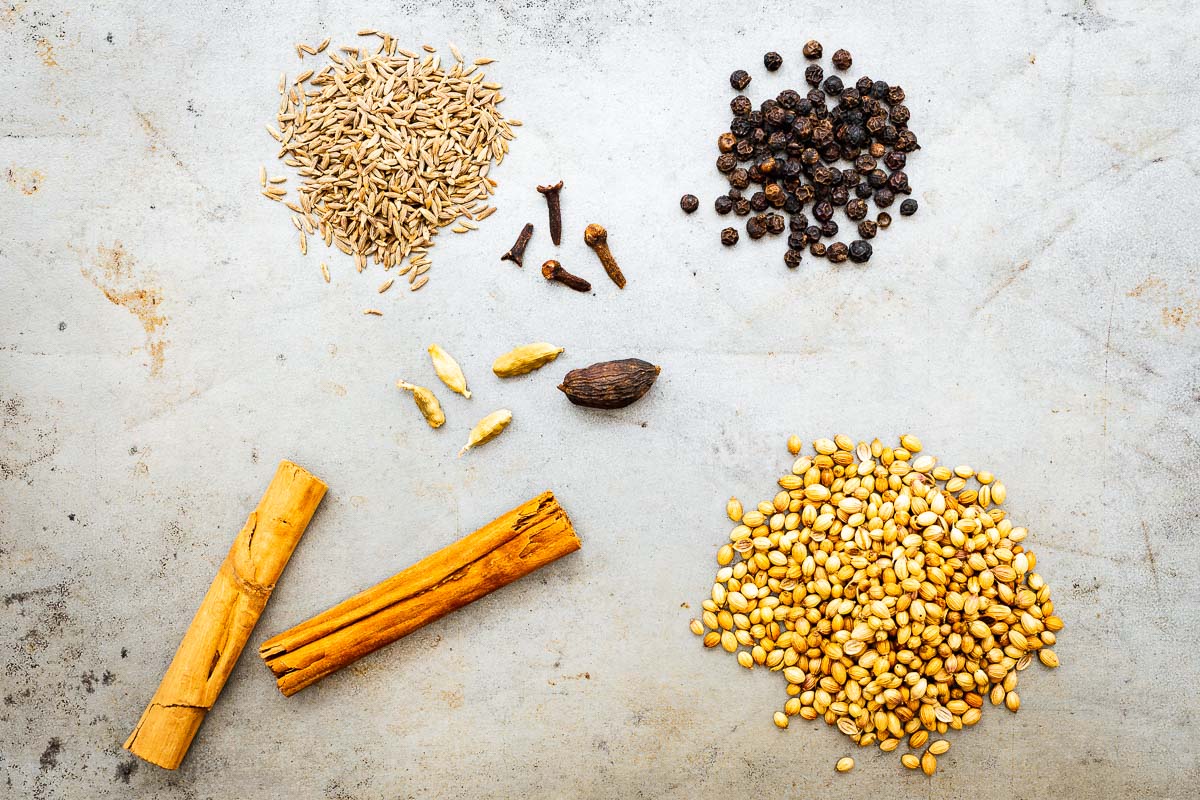
4. Cumin, coriander and cinnamon
This ground spice mix is your best option when you only need a little bit of garam masala. And it requires only three ingredients – all of them spice rack staples. It has the warm aromatic flavour and citrusy notes of a good garam masala.
Mix one part ground coriander and one part ground cumin to half a part cinnamon for an easy garam masala alternative.
So, to make a tablespoon of garam masala substitute, use a heaped teaspoon each of ground coriander and cumin with half a teaspoon of cinnamon.
Use this spice blend as a direct substitute for garam masala. And add some freshly ground black pepper to your finished dish for an even closer flavour match.
5. Curry powder
Garam masala and curry powder are both ground spice blends featuring typical Indian spices. But their flavour profile can be very different.
Curry powder typically contains a blend of spices, including coriander, cumin, turmeric, ginger, mustard, fenugreek, and chilli powder.
Although some of these spices are also in garam masala, garam masala is less spicy (it has no chillies) with a warmer, sweet flavour. Another major difference is the lack of turmeric in garam masala.
So, while mild curry powder can work as a replacement in a pinch, it’s not an exact match.
If you use curry powder as a direct substitute for garam masala, adjust the other spices in the recipe to balance the flavours. Try an extra pinch of cinnamon, cumin and black pepper. And remember that curry powder is hotter than garam masala!
Try this curry powder recipe (with curry powder substitutes) for homemade curry powder.
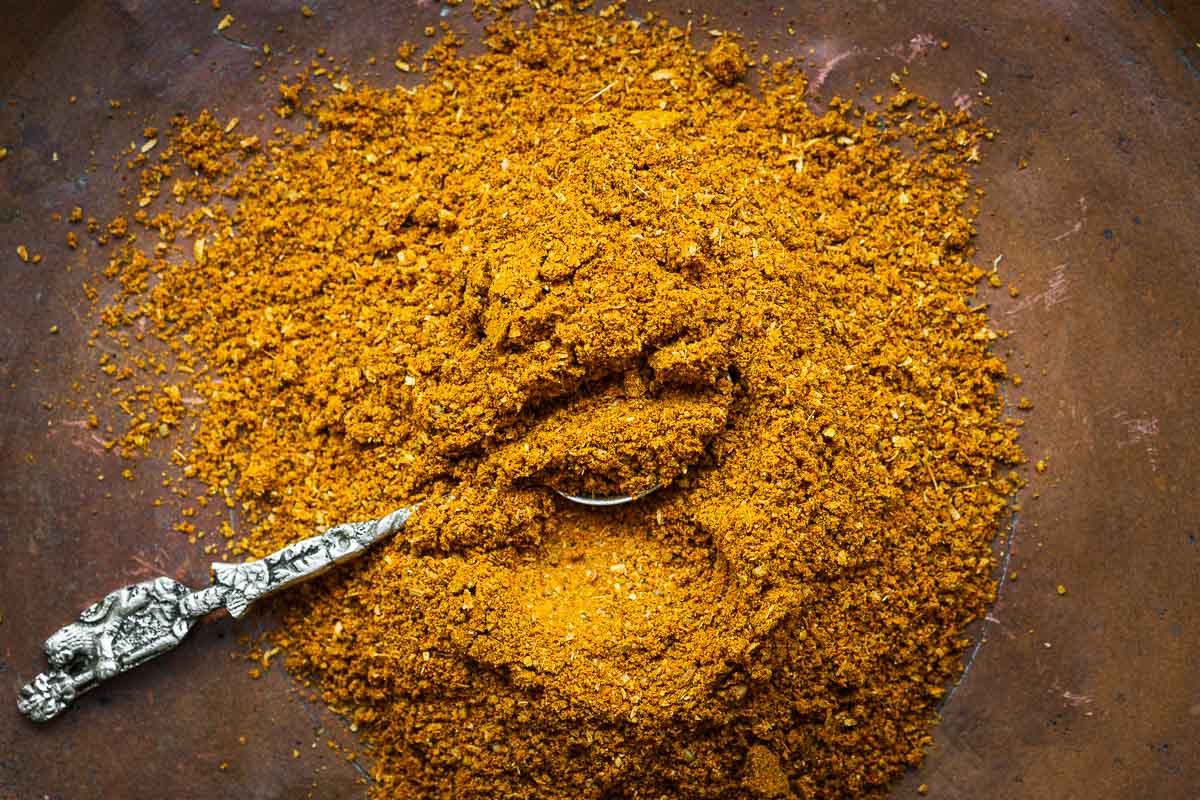
6. Chinese five-spice
Another potential substitute for garam masala is Chinese five-spice powder. The popular spice mix contains cinnamon, star anise, fennel, cloves, and Szechuan peppercorns (sometimes omitted in shop-bought five-spice).
While Chinese five-spice powder may not seem like an obvious substitute for an Indian spice blend due to its Chinese origin, it can add a unique and delicious flavour to your dishes.
Chinese five-spice and garam masala both contain warming spices like cinnamon and star anise. But five-spice has a stronger liquorice-like flavour, and some blends have that classic mouth-numbing effect of Szechuan peppercorns. It has a stronger effect than mace – an optional ingredient in garam masala. Therefore five-spice blends without Szechuan make a better garam masala alternative.
Try Chinese five-spice as an adventurous substitute for garam masala. And adjust the flavour profile with a few garam masala essential ingredients like a pinch of ground cumin, coriander, cardamom and cloves.
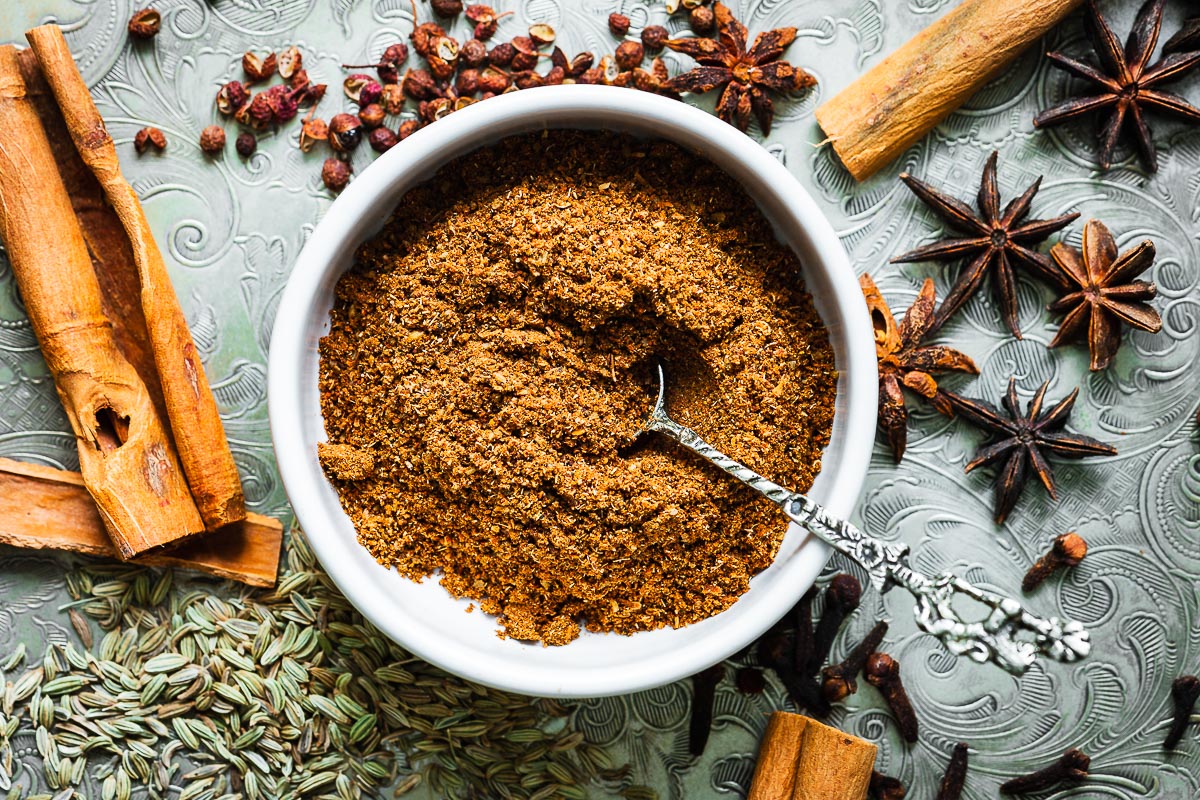
7. Allspice
A good single-spice alternative to garam masala is allspice, which has a warm, sweet, and slightly spicy flavour.
With such a multidimensional flavour profile, it makes sense that ground allspice is often mistaken for a spice blend. But it is the dried berries of the pimenta dioica plant.
You can use allspice as a direct replacement for garam masala. It has the warm flavours of cinnamon, nutmeg and cloves.
But for an even closer match, add the missing essential garam masala flavours. Try a pinch of ground cumin, coriander, cardamom and black pepper.
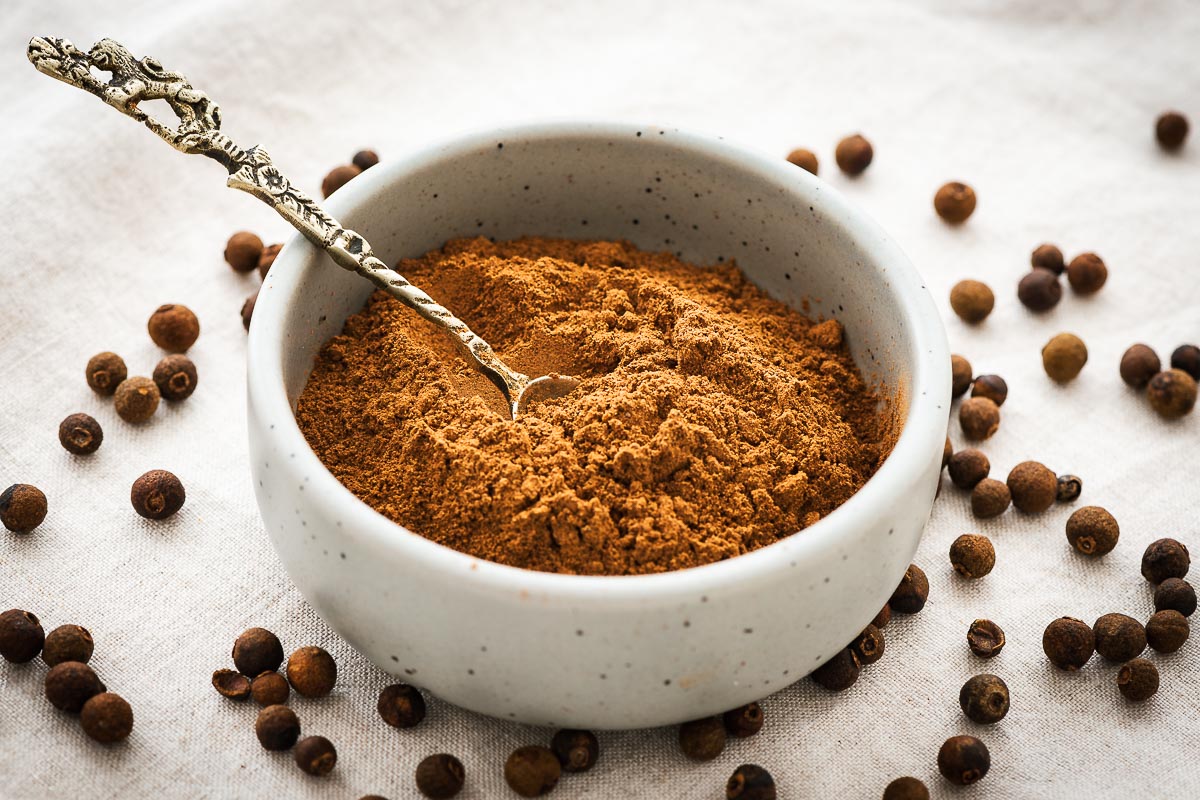
8. Pumpkin spice
Pumpkin spice (or pumpkin pie spice) is a blend of spices common in North American cuisine. It contains cinnamon, nutmeg, allspice, and ginger, which gives it a warm spiced flavour. Some brands also add cloves or caraway seeds.
While pumpkin spice is a surprising alternative to garam masala, it contains many of the spices that give garam masala its warm aromatic flavour.
You can use pumpkin spice as a direct substitute for garam masala.
But, for an even better garam masala alternative, add the missing spices that give garam masala its earthy and citrusy notes. Try a teaspoon of pumpkin spice with a pinch of ground cumin, coriander, cardamom and black pepper for a great garam masala substitute in sweet and savoury dishes.
9. Lebanese seven-spice (baharat)
Bahārāt is the Arabic word for spices. And Lebanese seven-spice is often simply called baharat, even though baharat can include more than seven ingredients.
The spices in Lebanese seven-spice vary. Most blends have cinnamon, ginger, allspice, black peppercorns and cloves. The remaining two ingredients can be cardamom, coriander, cumin, nutmeg, fenugreek or mahlab.
I’m sure you can spot the common ingredients between seven-spice and garam masala. The best seven-spice to use as an alternative for garam masala is a blend without fenugreek seeds. Fenugreek has a pungent and sometimes bitter flavour that can overpower the subtle spice mix.
You can use Lebanese seven-spice as a direct substitute for garam masala but check the ingredients label first. If your shop-bought seven-spice does not contain coriander, cumin or cardamom, add a pinch of each missing ingredient per teaspoon of seven-spice for a more balanced garam masala alternative.
10. Ras el hanout
Ras el hanout means head of the shop in Arabic. The exact spice mix varies across shops in Tunisia, Algeria and Morocco, but it typically contains aromatic and warm spices such as cumin, coriander, cinnamon, and cardamom.
While it’s not an Indian ingredient, it can have a similar flavour profile to garam masala, depending on the exact blend of spices. Use it as a substitute for garam masala in dishes that require a warm aromatic flavour profile.
Ras el hanout can also include ingredients not found in garam masala, like ground ginger, chilli peppers, sweet or hot paprika, fenugreek and turmeric.
Since the ingredients in ras el hanout vary greatly, it is best to read the ingredient list carefully and adjust the spices accordingly when you use it as a garam masala alternative. And if the texture is coarse, grind it in a spice grinder (or mortar and pestle) for a finer powder.
NOT the best substitutes
Sambar masala
While both sambar masala powder and garam masala are common in Indian cuisine, they are distinct masala blends with unique flavour profiles.
Sambar masala includes coriander seeds, cumin, mustard seeds, fenugreek, turmeric, red chilli powder, and dal. It’s a typical ingredient in the South Indian lentil-based vegetable stew, sambar.
In contrast, as we’ve seen so far, garam masala comprises warm spices like cinnamon, cardamom, cloves, cumin, and coriander. It’s often used at the end of cooking to provide warmth and depth to dishes like curries and biryanis.
While sambar masala can be a flavourful substitute for garam masala in a pinch, the resulting dish will have a completely different flavour profile.
If you run out of garam masala, a better option would be to use a blend of warm spices like cinnamon, cardamom, and cloves, make your own garam masala, or try another better alternative from the list of best garam masala substitutes.
Don’t use chaat masala as a substitute for garam masala
You might think that chaat masala would make a good substitute for garam masala because they sound so similar. But you would be wrong. Chaat masala is not a good garam masala substitute in cooking.
The word masala refers to any ground spice mixture. Chaat masala and garam masala are both Indian spice blends, but they are not the same. They have drastically different flavour profiles.
Chaat masala is tart and pungent. It contains amchoor (dried mango powder), cumin, coriander, ground ginger, salt (often the sulphuric black salt called kala namak), black pepper, asafoetida, and chilli powder. And garam masala has warm, earthy spices with a slightly sweet flavour thanks to cinnamon, star anise and more spices.
Want a seasoning blend to sprinkle over fresh fruit or street food-style snacks? Chaat masala is your mix. But don’t use chaat masala as a substitute for garam masala in savoury dishes.
Frequently asked questions
While hot curry powder is not a good substitute for garam masala, you can use mild curry powder to add depth of flavour in a pinch. Add extra ground cinnamon and cardamom to better match the warm, complex flavour profile of garam masala.
Garam masala is a blend of warm and aromatic spices that vary depending on the recipe and region. But typical ingredients include cumin, coriander seeds, cardamom (black or green), cinnamon, cloves, black peppercorns, mace, mustard seeds, fennel and star anise.
Garam masala and curry powder are both ground spice blends. But they have very different flavour profiles. Garam masala is warm, aromatic and not spicy. Curry powders range from mild to very hot, with a deep orange colour due to turmeric. Garam masala contains no turmeric and has a reddish-brown colour.
Chaat masala and garam masala are not the same thing. Chaat masala is a tangy and pungent spice blend containing dried mango typically used in Indian street food and snacks. Garam masala is a warm and aromatic spice blend commonly used in soups and stews across the Indian subcontinent.
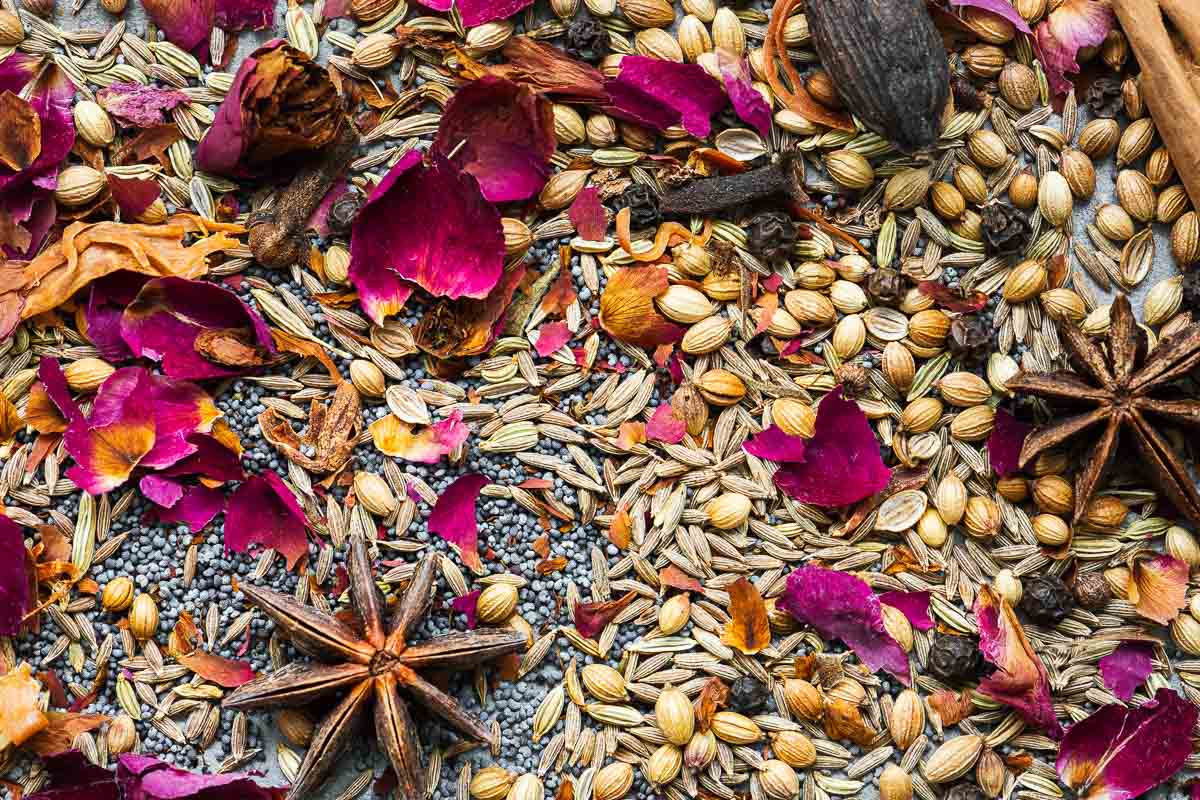
Garam masala is a key ingredient in many Indian and South Asian dishes, but there is no need to worry if you’ve run out. This post lists several great substitutes you can use.
Experiment with different combinations of spices and get creative in the kitchen. Let me know which substitute worked best for you in the comments below!
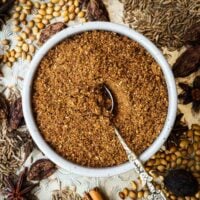
Equipment
Ingredients
- 2 cinnamon sticks
- 2 tablespoons coriander seeds
- 2 teaspoons cumin seeds
- 2 teaspoon fennel seeds
- 2 whole pods star anise
- 2 teaspoons black peppercorns
- 1 black cardamom pod, whole pod
- 4 green cardamom pods, seeds only
- 4 cloves
- 1 bay leaf
- 10 mace blades (1 scant tablespoon)
- 2 teaspoons poppy seeds (optional)
- 1 tablespoon dried rose petals (optional)
Instructions
Oven method:
- Heat a conventional oven to 160 °F. Spread everything apart from the poppy seeds and rose petals on a baking sheet. Place the baking tray in the oven for 2 ½ hours.
- Add the poppy seeds and rose petals to the tray, place it back in the oven and turn the oven off. Allow the mixture to cool in the switched-off oven for 30 minutes.
- Transfer the cooled spice mix to a spice grinder (or coffee grinder) and blitz it into a fine powder.
Stovetop method:
- Put everything apart from the poppy seeds and rose petals into a cold, dry frying pan or skillet and place over medium-high heat. Toast the spices for 3 minutes, shaking the pan occasionally.
- Remove the pan from the heat and add the poppy seeds and rose petals. Let the mixture cool in the pan.
- Transfer the cooled spice mix to a spice grinder (or coffee grinder) and blitz it into a fine powder.
Notes
- Lower the temperature if you have a fan oven. I suggest 120 °F (50 °C) but check on the spices every 30 minutes to ensure they are getting sufficient heat without burning.
- While the spice mix won’t go off anytime soon, spices start to lose their intensity as soon as you grind them. So, for the best flavour, aim to use homemade spice blends within 30 days.
- If you don’t have a spice grinder, try this complex garam masala substitute (from ground spices) instead. Or, if you only have basic staple spices, try the simple garam masala spice mix (with main garam masala ingredients only).
